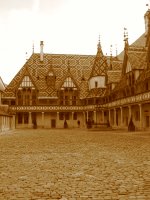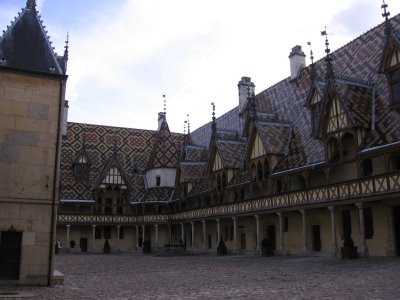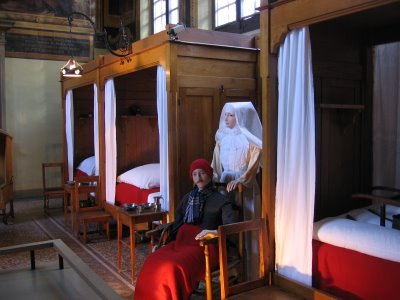The Roof of the Hôtel-Dieu

Actually, I really don't have too much to say about Dijon or Burgundy. Dijon is a pleasant enough little city for a stroll. The old architecture is a delight, but there's not much going on in town. Outside of the foire I didn't eat anything that knocked my socks off. Traditional Burgundian cuisine is rather rich and heavy. The veal kidneys with a three-mustard cream sauce I had at one place is, I think, pretty typical.
I took a day trip to Beaune, a very touristy Burgundian town, though sleepy in the off-season. It's one of those cute places that make the itinerary because I don't want to miss something the books tell me I shouldn't miss, slave to conventional wisdom that I am. Ultimately, though, I don't have too much use for them. These "living museum" types of places (Bruges and Toledo are other, more famous ones) have their share of interest, but one misses the authentic life of a vibrant city, especially in the summer when the streets of those cute little day trip towns are swarming with tourists all vying for the same attractions at the same time. So you visit for four or five hours, then you get back to wherever it is you're staying, unless you happen to be staying wherever it is you happen to be. But what am I complaining about? I was in Beaune in November and it was hardly crowded.
Many people visit Beaune for tastings at the wine caves. But I'm not much of a wine drinker. You may have noticed that at the foire I only drank whites. That's because I get splitting headaches from red wines. The culprit is probably histamines or tannins from the grape skins. I'm fine with whites, so it's not sulfites. Jeffrey Steingarten would probably say it's a baseless food phobia (you followed that link to "The Omnivore," right?).

The highlight of a visit to Beaune is its most famous attraction, the Hôtel-Dieu and the spectacular Burgundian tile work of its roof. The Hôtel-Dieu was built in the fifteenth century and served as a hospice for the town's sick and needy. Its founder and benefactor, Nicolas Rolin, envisioned it as a palace for the poor, and among the treasures he furnished it with is a polyptich attributed to Rogier van der Weyden. Remarkably, the Hôtel served its function as General Hospital through the 1960s. It is now a museum, and one can walk through the former wards and get a feel for a hospital of old (aided by mannequins of nuns and patients), as well as enjoy the art and artifacts in its galleries. If you'd like more information, guidebooks do a much better job than I can. I'll just leave you with a few more photos of the Hôtel.







0 Comments:
Post a Comment
<< Home